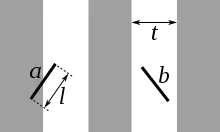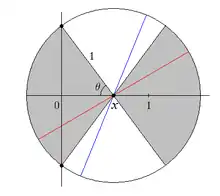Buffon's needle problem
In mathematics, Buffon's needle problem is a question first posed in the 18th century by Georges-Louis Leclerc, Comte de Buffon:[1]
- Suppose we have a floor made of parallel strips of wood, each the same width, and we drop a needle onto the floor. What is the probability that the needle will lie across a line between two strips?

Buffon's needle was the earliest problem in geometric probability to be solved; it can be solved using integral geometry. The solution for the sought probability p, in the case where the needle length l is not greater than the width t of the strips, is
This can be used to design a Monte Carlo method for approximating the number π, although that was not the original motivation for de Buffon's question.[2]
Solution
The problem in more mathematical terms is: Given a needle of length dropped on a plane ruled with parallel lines t units apart, what is the probability that the needle will lie across a line upon landing?
Let x be the distance from the center of the needle to the closest parallel line, and let θ be the acute angle between the needle and one of the parallel lines.
The uniform probability density function of x between 0 and t /2 is
Here, x = 0 represents a needle that is centered directly on a line, and x = t/2 represents a needle that is perfectly centered between two lines. The uniform PDF assumes the needle is equally likely to fall anywhere in this range, but could not fall outside of it.
The uniform probability density function of θ between 0 and π/2 is
Here, θ = 0 radians represents a needle that is parallel to the marked lines, and θ = π/2 radians represents a needle that is perpendicular to the marked lines. Any angle within this range is assumed an equally likely outcome.
The two random variables, x and θ, are independent, so the joint probability density function is the product
The needle crosses a line if
Now there are two cases.
Case 1: Short needle
Integrating the joint probability density function gives the probability that the needle will cross a line:
Case 2: Long needle
Suppose . In this case, integrating the joint probability density function, we obtain:
where is the minimum between and .
Thus, performing the above integration, we see that, when , the probability that the needle will cross a line is
or
In the second expression, the first term represents the probability of the angle of the needle being such that it will always cross at least one line. The right term represents the probability that, the needle falls at an angle where its position matters, and it crosses the line.
Alternatively notice that whenever has a value such that , that is, in the range the probability of crossing is the same as in the short needle case. However if , that is, the probability is constant and is equal to 1.
Using elementary calculus
The following solution for the "short needle" case, while equivalent to the one above, has a more visual flavor, and avoids iterated integrals.
We can calculate the probability as the product of 2 probabilities: , where is the probability that the center of the needle falls close enough to a line for the needle to possibly cross it, and is the probability that the needle actually crosses the line, given that the center is within reach.
Looking at the illustration in the above section, it is apparent that the needle can cross a line if the center of the needle is within units of either side of the strip. Adding from both sides and dividing by the whole width , we obtain

Now, we assume that the center is within reach of the edge of the strip, and calculate . To simplify the calculation, we can assume that .
Let x and θ be as in the illustration in this section. Placing a needle's center at x, the needle will cross the vertical axis if it falls within a range of 2θ radians, out of π radians of possible orientations. This represents the gray area to the left of x in the figure. For a fixed x, we can express θ as a function of x: . Now we can let x move from 0 to 1, and integrate:
Multiplying both results, we obtain , as above.
There is an even more elegant and simple method of calculating the "short needle case". The end of the needle farthest away from any one of the two lines bordering its region must be located within a horizontal (perpendicular to the bordering lines) distance of (where is the angle between the needle and the horizontal) from this line in order for the needle to cross it. The farthest this end of the needle can move away from this line horizontally in its region is . The probability that the farthest end of the needle is located no more than a distance away from the line (and thus that the needle crosses the line) out of the total distance it can move in its region for is given by
, as above.
Without integrals
The short-needle problem can also be solved without any integration, in a way that explains the formula for p from the geometric fact that a circle of diameter t will cross the distance t strips always (i.e. with probability 1) in exactly two spots. This solution was given by Joseph-Émile Barbier in 1860[3] and is also referred to as "Buffon's noodle".
Estimating π

(2l·n)/(th)=(2·9·17)/(9·11)≈3.1≈π.

In the first, simpler case above, the formula obtained for the probability can be rearranged to:
Thus, if we conduct an experiment to estimate , we will also have an estimate for π.
Suppose we drop n needles and find that h of those needles are crossing lines, so is approximated by the fraction . This leads to the formula:
In 1901, Italian mathematician Mario Lazzarini performed Buffon's needle experiment. Tossing a needle 3408 times, he obtained the well-known approximation 355/113 for π, accurate to six significant digits.[4] Lazzarini's "experiment" is an example of confirmation bias, as it was set up to replicate the already well-known approximation of 355/113 (in fact, there is no better rational approximation with fewer than five digits in the numerator and denominator), yielding a more accurate "prediction" of π than would be expected from the number of trials, as follows: [5]
Lazzarini chose needles whose length was 5/6 of the width of the strips of wood. In this case, the probability that the needles will cross the lines is . Thus if one were to drop n needles and get x crossings, one would estimate π as:
So if Lazzarini was aiming for the result 355/113, he needed n and x such that:
or equivalently,
To do this, one should pick n as a multiple of 213, because then is an integer; one then drops n needles, and hopes for exactly successes.
If one drops 213 needles and happens to get 113 successes, then one can triumphantly report an estimate of π accurate to six decimal places. If not, one can just do 213 more trials and hope for a total of 226 successes; if not, just repeat as necessary. Lazzarini performed 3408 = 213 · 16 trials, making it seem likely that this is the strategy he used to obtain his "estimate."
The above description of strategy might even be considered charitable to Lazzarini. A statistical analysis of intermediate results he reported for fewer tosses leads to a very low probability of achieving such close agreement to the expected value all through the experiment. This makes it very possible that the "experiment" itself was never physically performed, but based on numbers concocted from imagination to match statistical expectations, but too well, as it turns out.[5]
Dutch science journalist Hans van Maanen argues, however, that Lazzarini's article was never meant to be taken too seriously as it would have been pretty obvious for the readers of the magazine (aimed at school teachers) that the apparatus that Lazzarini said to have built cannot possibly work as described.[6]
References
- de l'Acad. Roy. des. Sciences (1733), 43–45; naturelle, générale et particulière Supplément 4 (1777), p. 46.
- Behrends, Ehrhard. "Buffon: Hat er Stöckchen geworfen oder hat er nicht?" (PDF). Retrieved 14 March 2015.
- Aigner, Martin; Ziegler, Günter M. (2013). Proofs from THE BOOK (2nd ed.). Springer Science & Business Media. pp. 189–192.
- Lazzarini, M. (1901). "Un'applicazione del calcolo della probabilità alla ricerca sperimentale di un valore approssimato di π" [An Application of Probability Theory to Experimental Research of an Approximation of π]. Periodico di Matematica per l'Insegnamento Secondario (in Italian). 4: 140–143.
- Lee Badger, 'Lazzarini's Lucky Approximation of π', Mathematics Magazine 67, 1994, 83–91.
- Hans van Maanen, 'Het stokje van Lazzarini' (Lazzarini's stick), "Skepter" 31.3, 2018.
Bibliography
- Badger, Lee (April 1994). "Lazzarini's Lucky Approximation of π". Mathematics Magazine. Mathematical Association of America. 67 (2): 83–91. doi:10.2307/2690682. JSTOR 2690682.
- Ramaley, J. F. (October 1969). "Buffon's Noodle Problem". The American Mathematical Monthly. Mathematical Association of America. 76 (8): 916–918. doi:10.2307/2317945. JSTOR 2317945.
- Mathai, A. M. (1999). An Introduction to Geometrical Probability. Newark: Gordon & Breach. p. 5. ISBN 978-90-5699-681-9.
- Dell, Zachary; Franklin, Scott V. (September 2009). "The Buffon-Laplace needle problem in three dimensions". Journal of Statistical Mechanics: Theory and Experiment. 2009 (9): 010. Bibcode:2009JSMTE..09..010D. doi:10.1088/1742-5468/2009/09/P09010.
- Schroeder, L. (1974). "Buffon's needle problem: An exciting application of many mathematical concepts". Mathematics Teacher, 67 (2), 183–6.
External links
| Wikimedia Commons has media related to Buffon's needle. |
- Buffon's Needle Problem at cut-the-knot
- Math Surprises: Buffon's Noodle at cut-the-knot
- MSTE: Buffon's Needle
- Buffon's Needle Java Applet
- Estimating PI Visualization (Flash)
- Buffon's needle: fun and fundamentals (presentation) at slideshare
- Animations for the Simulation of Buffon's Needle by Yihui Xie using the R package animation
- 3D Physical Animation by Jeffrey Ventrella
- Padilla, Tony. "∏ Pi and Buffon's Needle". Numberphile. Brady Haran. Archived from the original on 2013-05-17. Retrieved 2013-04-09.